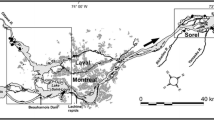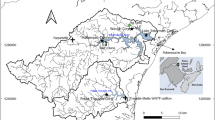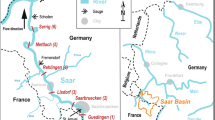Abstract
The mid Hudson River is a heterotrophic system where allochthonous inputs apparently fuel the largest proportion of secondary production and ecosystem metabolism. We have analyzed a 6-yr dataset collected quarterly at six stations spanning a 150-km reach to assess variability at inter- and intra-annual time scales and regional spatial scales. The major components of the lower food web: bacterial biomass, detrital particulate organic carbon (POC), and dissolved organic carbon (DOC), show surprisingly discordant patterns in temporal and spatial variability. Bacterial abundance shows significant variability at all three scales, but the interannual variability is by far the greatest. DOC concentrations showed greatest variability among years, with intra-annual and spatial variability roughly equal. Freshwater flow is commonly considered a major driving force in river-estuarine variability but simple discharge was not a strong predictor of any component of suspended matter or DOC. For organisms in the Hudson River food web, these multiple scales of variability indicate highly unpredictable food resources in time and space, and these fluctuations may contribute to the variability in higher trophic levels.
Similar content being viewed by others
Literature Cited
Coffin, R. B. andJ. H. Sharp. 1987. Microbial trophodynamics in the Delaware Estuary.Marine Ecology Progress Series 41:253–266.
Cole, J. J., N. F. Caraco, andB. Peirls. 1992. Can phytoplankton maintain a positive carbon balance in a turbid, freshwater, tidal estuary?Limnology and Oceanography 37:1608–1617.
Findlay, S., M. L. Pace, andD. Lints. 1991a. Scales of variability and transport of suspended sediment, particulate, and dissolved organic carbon in the tidal, freshwater Hudson River.Biogeochemistry 12:149–169.
Findlay, S., M. L. Pace, D. Lints, J. J. Cole, N. F. Caraco, andB. Peierls. 1991b. Weak coupling of bacterial and algal production in a heterotrophic ecosystem, the Hudson. estuary.Limnology and Oceanography 36:268–278.
Gladden, J. B., F. R. Cantelmo, J. M. Croom, andR. Shapot. 1988. Evaluation of the Hudson River ecosystem in relation to the dynamics of fish populations.American Fisheries Society Monography 4:37–52.
Ittekkot, V. andR. W. P. M. Laane. 1991. Fate of riverine particulate organic matter, p. 233–243.In E. T. Degens, S. Kempe, and J. Richey (eds.), Biogeochemistry of Major World Rivers. SCOPE Report 42. John Wiley & Sons, Chichester, England.
Junk, W. J., P. B. Bayley, and R. E. Sparks. 1989. The flood pulse concept in river-floodplain systems, p. 110–127.In D. P. Dodge (ed.), Proceedings of the International Large Rever Symposium, Canadian Special Publications of Fisheries and Aquatic Sciences 106.
Lehman, P. W. 1992. Environmental factors associated with long-term changes in chlorophyll concentration in the Sacramento-San Joaquin Delta and Suisun Bay, California.Estuaries 15:335–348.
Mancroni, W. J., M. W. Daley, andW. Dey. 1992. Recent trends and patterns in selected water quality parameters in the mid-Hudson River estuary, p. 59–81.In C. L. Smith (ed.), Estuarine Research in the 1980’s. State University of New York Press, Albany, New York.
Meybeck, M. 1982. Carbon, nitrogen and phosphorus transport by world rivers.American Journal of Science 282:282–450.
Newell, S. Y., R. D. Fallon, B. F. Sherr, andE. B. Sherr. 1988. Mesoscale temporal variation in bacterial standing crop, percent active cells, productivity and output in a salt-marsh tidal river.Verhandlungen—Internationale Vereiningung fur Theoretische und Angewandte Limnologie 23:1839–1845.
Palumbo, A. V. andR. L. Ferguson. 1978. Distribution of suspended bacteria in the Newport River Estuary, North Carolina.Estuarine, Coastal and Shelf Science 7:521–529.
Parsons, T. R., M. Takahashi, andB. Hargrave. 1977. Biological Oceanographic Processes, 2nd edition. Pergamon Press, New York.
Pritchard, D. W. andW. V. Burt. 1951. An inexpensive and rapid technique for obtaining current profiles in estuarine waters.Journal of Marine Research 10:180–189.
Roman, M. R. 1978. Tidal resuspension in Buzzards Bay, Massachusetts. II. Seasonal changes in the size distribution of chlorophyll, particle concentration, carbon and nitrogen in resuspended particulate matter.Estuarine and Coastal Marine Science 6:47–53.
Shiah, F.-K. andH. W. Ducklow. 1994. Temperature and substrate regulation of bacterial abundance, production and specific growth rate in Chesapeake Bay, USA.Marine Ecology—Progress Series 103:297–308.
Spitzy, A. andJ. Leenheer. 1991. Dissolved organic carbon in rivers, p. 213–232.In E. T. Degens, S. Kempe, and J. E. Richey (eds.), Biogeochemistry of Major World Rivers, John Wiley and Sons, Chichester; England.
Valiela, I., K. Foreman, M. LaMontagne, D. Hersh, J. Costa, P. Peckol, B. DeMeo-Andreson, C. D’Avanzo, M. Babione, C.-H. Sham, J. Brawley, andK. Lajtha 1992. Couplings of watersheds and coastal waters: Sources and consequences of nutrient enrichment in Waquoit Bay, Massachusetts.Estuaries 15:443–457.
Vaqué, D., M. L. Pace, S. Findlay andD. Lints. 1992. Fate of bacterial production in a heterotrophic ecosystem: Grazing by protozoans and metazoans in the Hudson Estuary.Marine Ecology—Progress Series 89:155–163.
Wainwright, S. C. 1987. Stimulation of heterotrophic microplankton production by resuspended marine sediments.Science 238:1710–1712.
White, P. A., J. Kalff, J. B. Rasmussen, andJ. M. Gasol. 1991. The effects of temperature and algal biomass on bacterial production and specific growth rate in freshwater and marine habitats.Microbial Ecology 21:99–118.
Whittaker, R. H. andG. E. Likens. 1973. Carbon in the biota, p. 281–302.In G. Woodwell and E. Pecan (eds.), Carbon and the Biosphere. United States Atomic Energy Commission. Springfield, Virginia.
Wolfe, D. A. andB. Kjerfve. 1986. Estuarine variability: An overview, p. 3–17.In D. A. Wolfe (ed.), Estuarine Variability. Academic Press, Inc., Orlando, Florida.
Wright, R. T. andR. B. Coffin. 1983. Planktonic bacteria in estuaries and coastal waters of northern Massachusetts: Spatial and temporal distribution.Marine Ecology—Progress Series 11: 205–216.
Author information
Authors and Affiliations
Rights and permissions
About this article
Cite this article
Findlay, S., Pace, M. & Fischer, D. Spatial and temporal variability in the lower food web of the tidal freshwater Hudson River. Estuaries 19, 866–873 (1996). https://doi.org/10.2307/1352303
Received:
Accepted:
Issue Date:
DOI: https://doi.org/10.2307/1352303




